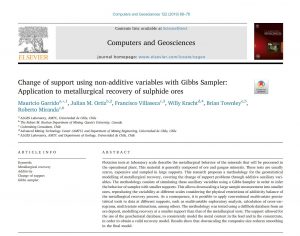 Another paper published in Computers & Geosciences. You can download it here.
Another paper published in Computers & Geosciences. You can download it here.
Change of support using non-additive variables with Gibbs Sampler: Application to metallurgical recovery of sulphide ores
Mauricio Garrido (ALGES Laboratory, AMTC, Universidad de Chile, Chile), Julian M. Ortiz (The Robert M. Buchan Department of Mining, Queen’s University, Canada), Francisco Villaseca (Codemining Consultant, Chile), Willy Kracht (Advanced Mining Technology Center (AMTC) and Department of Mining Engineering, Universidad de Chile, Chile), Brian Townley (ALGES Laboratory, AMTC and Department of Geology, Universidad de Chile, Chile), Roberto Miranda (Codemining Consultant, Chile)
Abstract
Flotation tests at laboratory scale describe the metallurgical behavior of the minerals that will be processed in the operational plant. This material is generally composed of ore and gangue minerals. These tests are usually scarce, expensive and sampled in large supports. This research proposes a methodology for the geostatistical modelling of metallurgical recovery, covering the change of support problems through additive auxiliary variables. The methodology consists of simulating these auxiliary variables using a Gibbs Sampler in order to infer the behavior of samples with smaller supports. This allows downscaling a large sample measurement into smaller ones, reproducing the variability at different scales considering the physical restrictions of additivity balance of the metallurgical recovery process. As a consequence, it is possible to apply conventional multivariate geostatistical tools to data at different supports, such as multivariable exploratory analysis, calculation of cross-variograms, multivariate estimations, among others. The methodology was tested using a drillhole database from an ore deposit, modelling recovery at a smaller support than that of the metallurgical tests. The support allowed for the use of the geochemical database, to consistently model the metal content in the feed and in the concentrate, in order to obtain a valid recovery model. Results show that downscaling the composite size reduces smoothing in the final model.
